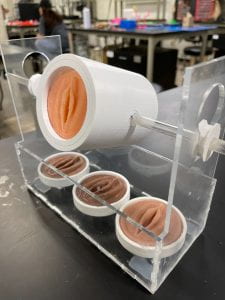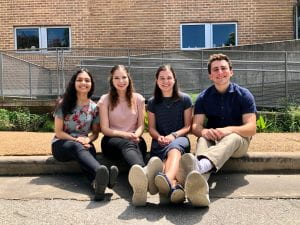*Content warning: My project deals with pediatric sexual assault. Please exercise self-care while reading.
When I was younger, I would often take care to only step inside the little boxes whenever I walked on tiled floors or floors with square patterns. This sometimes meant that I would restrict my stride just to stay inside the boxes.
When I took my first step into the OEDK on day one of this internship, it didn’t just feel like I was stepping on a line…it felt like I was stepping off the floor itself, into some sort of gap where I didn’t belong. I was apprehensive and nervous. Would I be the only non-engineer in an engineering design internship? Would I drag teammates down because I didn’t have much of a technical background? Should I have restricted my stride?
These past six weeks utterly transformed my perspective. Our internship cohort brought such an incredibly vast array of interests, skills, backgrounds, and life experiences, and I strongly believe that our diversity is in part what enabled us to accomplish as much as we did this summer. Team PIPER was no exception – Elise, Shannon, Alex, and I are such drastically different people, but we were brought together by our shared investment in our project (to the point that we’re now basically a family). I learned so much from each of them, whether it be technical skills or a stories about themselves as people.
Last week’s final showcase was one of the most empowering experiences of this whole internship. I had gotten so used to listening to teams give small updates on their progress during our daily morning stand-up meetings that I had failed to realize the extent of what we had really done, and the impact of what we had done. Team PIPER had left our first client meeting at the beginning of the internship overwhelmed – how were we supposed to start a project completely from scratch, and produce a functional pediatric pelvic model in a little over a month? Seeing everyone’s presentations at the final showcase, I realized that the real beauty of the engineering design process, and of engineering solutions to health issues, is those small incremental steps of progress. It’s not about whether your steps are perfect, or placed comfortably. Instead, it’s about the little daily updates, the little suggestions you get along the way from your teammates, your colleagues, your clients, the little tweaks and iterations on tiny components of your design. It’s the stepping stones that eventually bridge the gap you’re trying to address. And this realization allowed me to understand that progress isn’t defined by producing a perfect solution – it’s defined by whether you laid the next stepping stone, or made the existing path a little more even, a little smoother.

I’m so proud of team PIPER’s progress – though our prototype has some clear room for improvement, we still managed to develop a model that accomplishes many aspects of simulating a pediatric pelvic exam. Our model rotates properly between different positions, enables the interchange of labia and hymens, and facilitates realistic practice with labial traction and hymen observation. Here’s some images of the model we displayed at the showcase!
I’m intentionally choosing not to call our prototype, at the end of the internship, our “final” prototype. Why? Because we haven’t fully bridged the gap in pediatric sexual assault examination training. We may have laid enough stepping stones to get to the other side, but there’s still some gaps between steps, some rough edges, that can be worked on, like improving hymenal movement during rotation from supine to prone, or working more to standardize our molding and pigmentation process.
So what exactly are the next stepping stones to lay down? After our final presentation on Thursday, we found out that we may be able to get Institutional Review Board (IRB) approval for user testing of our model in time for a training event led by Ms. Harris (our client) in New York in early August. This is such exciting news – if we get IRB approval, we could publish our work in a journal! After a team meeting with Dr. Taylor and our client, we decided that we’d go ahead and start the process. While this is a short timeline and not guaranteed, we are hopeful that we will be able to publish data from user testing at some point in the near-ish future.
As far as next steps for the model itself, we will be sending our model to Ms. Harris soon so that she can at the very least get some informal feedback at her training. We also prepared documentation for project transfer, so that the PIPER project is prepared to be handed off to a future team. Elise, Shannon, Alex, and I are all interested in continuing to stay involved with this project, so instead of the end of this internship being a “goodbye,” it’s more of a “see you soon,” as Dr. Taylor phrased it on Friday. I’m incredibly grateful to have received so much support from Rice 360, the OEDK, and everyone else who made it possible for us to work on and contribute to such an important and impactful project. It still hasn’t sunk in for me that we started this project from scratch in June, and now have a functional pediatric pelvic model to send to New York for user testing.

Overall, I’m so honored to have met, worked with, and learned from the amazing people in this internship, many of whom I can now say are really good friends of mine. And as for team PIPER, we have an incredibly close bond and I really treasure the memories we made together (and all the inside jokes and even our very own PIPER Spotify playlist) these past six weeks. I learned so much from my experiences this summer, and I can’t wait to see all the amazing things that my fellow interns will do in the future.
One of my biggest takeaways from the summer is that when you’re a global health engineer, or a health innovator, or just anyone who is trying to develop a novel solution to something, your job isn’t to find a bridge for the gap – it’s to make the bridge, stone by stone. As I take this lesson with me, I will look for ways to step outside of those little squares of comfort. Most importantly, I will know that building a bridge of stepping stones isn’t just one person’s job – addressing community issues is a community effort.
I’ve appreciated the opportunity to document and reflect on my experiences in this blog. Thanks to everyone for reading my posts throughout this summer, and I will see you soon!
-Shivani